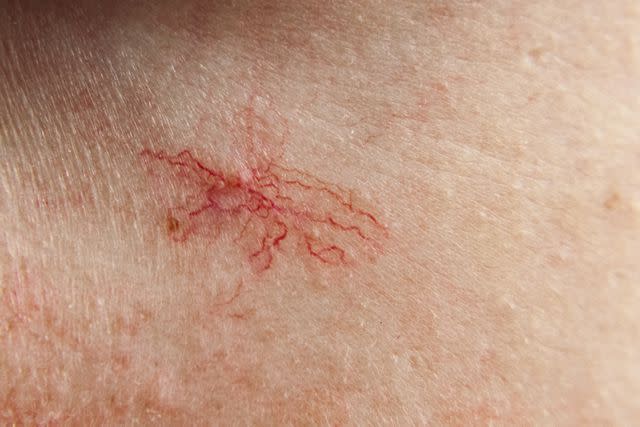Spider Angioma (Spider Nevus): Symptoms, Causes, and Treatments
Medically reviewed by Susan Bard, MD
A spider angioma is a benign lesion that gets its name based on its spiderlike appearance. Spider angiomas contain a body, legs, and surrounding reddened patches of skin caused by dilation of the capillaries. A spider angioma may also be called a spider telangiectasis or spider nevus.
Spider angiomas are common in healthy children and adults. However, having multiple spider angiomas may indicate a health problem, especially liver disease.
Learn more about the symptoms, causes, diagnosis, and treatment of spider angiomas.

Evgeniya Sheydt / Getty Images
Symptoms of Spider Angioma
A spider angioma is a painless lesion with a central red or purple dot in the center, averaging in size from 1 to 10 millimeters (mm). If you press on it, it will disappear, then reappear when pressure is released and blood fills back into the blood vessels.
Spider angiomas are most commonly found on the:
Face
Upper arms
Chest
Neck
Children commonly have them on the upper extremities, such as the arms, backs of hands, and fingers. They can also occur on the neck and trunk. On rare occasions, they'll bleed, usually when they are picked at or if they have experienced trauma. A spider angioma can grow in size over time.
Unless there is an underlying health condition associated with the angioma (such as liver disease), there are no symptoms except its physical appearance.
Spider Angiomas vs. Spider Veins and Cherry Angiomas
A spider angioma is a red spider-shaped lesion. Spider veins are blue and most often occur on the lower legs in people with varicose veins. Cherry angiomas are a red or purple oval dot without spiderlike legs. They are a benign lesion common in people over age 30, and many people have several of them.
What Causes Spider Angioma?
Spider angiomas occur when a small cluster of blood vessels comes to the skin's surface. Having one to three spider angiomas is common in children. Overall, they are seen in 10% to 15% of healthy individuals.
Estrogen can contribute to the development of spider angiomas, which is why the condition is more common in people taking oral contraceptives and during pregnancy. In these cases, a person may have multiple spider angiomas.
Multiple spider angiomas can also result from an underlying issue, such as cirrhosis of the liver, rheumatoid arthritis, and thyrotoxicosis (excess thyroid hormones in the body).
In people with cirrhosis of the liver, spider angiomas develop due to a multitude of factors, such as:
A disturbance of sex hormones
Angiogenesis (new blood vessels that support tissue growth)
Vasodilation (blood vessel dilatation)
Alcohol use disorder
Liver dysfunction
Diagnosing Spider Angiomas
Due to its distinct features, a spider angioma can be recognized by its appearance, and a healthcare provider or dermatologist can diagnose it. They rarely need to be biopsied (removing a sample tissue for analysis in a lab). However, you should get evaluated for underlying health conditions if you have more than a few.
If your healthcare provider suspects that your spider angiomas are due to liver disease, they may conduct blood tests to confirm liver problems.
How Do You Treat Spider Angiomas?
Depending on the size, spider angiomas can go away on their own. Children and adolescents with spider angiomas may see them resolve once they go through puberty. Pregnant people may see them disappear after they give birth.
Spider angiomas that are caused by an underlying health condition may go away once that condition is treated. If your spider angiomas are persistent and you want to have them removed, you can speak to your healthcare provider.
Options for treatment include:
Laser: A wand emits pulses of a powerful beam of coherent light on the area treated.
Electrodesiccation: This is a process of drying tissue using an electrode that transmits high-frequency electrical currents.
Prognosis
The prognosis is excellent unless the spider angioma is associated with end-stage liver disease. It has been noted that spider angiomas can go away after liver transplantation.
Coping
People with spider angiomas may not like how they appear aesthetically and choose to have them removed due to their appearance. If your spider angiomas are due to an underlying condition, treatment of that condition will be necessary.
Learning how to cope with a new situation can be difficult, but working with your medical team and finding support can ease the burden.
Do Spider Angiomas Go Away?
In many cases, spider angiomas will go away on their own, especially in children and pregnant people. However, in other adults, they tend to persist unless treated.
You can also choose to have them removed, but this can leave a scar. And sometimes, they can recur. It's always a good idea to have them examined, especially if you have multiple and they are persistent.
What Stage of Liver Disease Is Associated With Spider Angioma?
Spider angiomas are commonly associated with alcoholism, impaired liver function, alcoholic hepatitis, and hepatopulmonary syndrome (a condition that affects the lungs during advanced liver disease).
The stage of liver disease in which spider angiomas appear is not entirely clear. However, size and number can give a better indication of the severity of the disease.
The reported prevalence of spider angiomas in people with cirrhosis of the liver is 33%. People with spider angiomas and liver disease will likely experience symptoms of the disease, including jaundice, fluid retention, and confusion.
Summary
Spider angiomas are common skin lesions that get their name due to their spiderlike appearance. Most of the time, they are harmless and will go away on their own. However, if you have multiple spider angiomas and are experiencing other symptoms, such as yellowing of your skin (jaundice) and fluid retention, they can indicate liver disease.
Other contributing factors, such as liver cirrhosis or autoimmune disease, warrant medical diagnosis and treatment of the underlying condition. When in doubt, make an appointment with your medical team to be evaluated.
Read the original article on Verywell Health.

